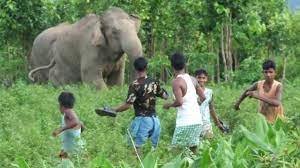New Delhi – As incidents of human-wildlife conflict continue to surface across the country, the Government of India has reaffirmed its commitment to managing these challenges through a multi-layered approach. Although the Ministry does not maintain centralized data on these occurrences, several key policies and support mechanisms have been introduced in recent years to mitigate the impact of such conflicts on both human and wildlife populations.
In February 2021, the Ministry of Environment, Forest and Climate Change issued an advisory outlining coordinated action plans for conflict-prone areas. The advisory emphasized inter-departmental coordination, identification of hotspots, formation of rapid response teams, and the establishment of State and District-level committees to ensure swift ex-gratia payments in cases of human injury or death—preferably within 24 hours.
Further strengthening this framework, guidelines were released in June 2022 for managing crop damage due to wildlife. These recommend States and Union Territories to utilize the Pradhan Mantri Fasal Bima Yojna for providing additional insurance coverage against wild animal attacks. The guidelines also advocate for alternate cropping strategies, including promoting plants that are unpalatable to wild animals and agroforestry practices using crops like lemongrass, chillies, and khus grass, combined with suitable tree species, especially in forest fringe regions.
Recognizing the need for tailored responses, the Ministry issued species-specific guidelines in March 2023. These include conflict mitigation strategies for frequently involved animals such as elephants, leopards, bears, wild pigs, crocodiles, rhesus macaques, blue bulls, and blackbucks, among others.
To support these efforts, the Centre extends financial assistance to States and Union Territories under various Centrally Sponsored Schemes, including the Development of Wildlife Habitats, Project Tiger, and Project Elephant. These funds are used to manage wildlife and protect habitats through the installation of physical barriers such as barbed wire, solar fencing, bio-fencing, and boundary walls to prevent animals from entering agricultural lands. Provisions also include capacity-building for frontline staff and ex-gratia compensation for damages caused by wild animals.
India’s protected area network—comprising National Parks, Wildlife Sanctuaries, Conservation Reserves, and Community Reserves—serves as a critical line of defence in preserving key habitats and minimizing human-wildlife overlap. Legal provisions under the Wildlife Protection Act, 1972 empower State authorities to act when wild animals pose a direct threat to human life or property, including granting limited permits for intervention under exceptional circumstances.
The Ministry has also issued comprehensive guidelines for developing management plans for protected areas and adjacent landscapes under Section 33 of the Act. Alongside structural efforts, consistent training and capacity-building support is provided to State Forest Department staff through specialized institutions like the Wildlife Institute of India and SACON, promoting the use of modern tools such as early warning systems and drone surveillance.
Public awareness remains a vital pillar of the strategy. States and UTs regularly conduct sensitization campaigns using media and outreach programs to educate communities living near wildlife habitats, urging caution and cooperation.
This comprehensive update was shared by Shri Kirti Vardhan Singh, Union Minister of State for Environment, Forest and Climate Change, in a written reply in the Lok Sabha, highlighting the Centre’s continuous efforts to balance ecological conservation with human safety and livelihood security.






